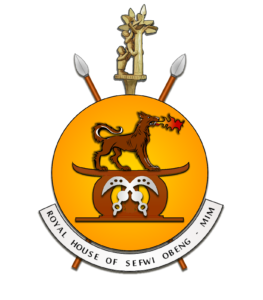dynastic orders
The Royal House of Sefwi Obeng-Mim
The stool land (kingdom) of Sefwi Obeng-Mim, under the Sefwi Wiawso Traditional Area, was constituted in 1935 under the first chief/king, Nana Kwame Obeng I. His Majesty, Obeng I, with his chief priest, ushered in reforms to the constitution and the ceremonial regalia (cloths, ornaments, and decorations). Even though the size of the kingdom seems small in comparison to other stool lands, it’s people and leaders have been a powerhouse in the development of not only their region but also the whole Traditional Area and post-colonial Ghana.
CHIEFTAINCY INSTITUTION IN GHANA
The chieftaincy institution in Ghana is a system that structures and regulates the activity of local chieftains (or monarchs) in the Ghanaian society and state. In 1925, when Ghana was called the British Gold Coast Colony, provincial councils of chiefs were established in all three territories of the colony, partly to give the chiefs a colony-wide function. The 1927 Native Administration Ordinance clarified and regulated the powers and areas of jurisdiction of chiefs and councils. In 1935 the Native Authorities Ordinance combined the central colonial government and the local authorities into a single governing system. New native authorities, appointed by the governor, were given wide powers of local government under the supervision of the central government’s provincial commissioners. The chieftaincy institution of Ghana has been enshrined in the Republic’s Constitution (chapter 270-277) and the Chieftaincy Act of 2008.
As a historical note, “chief” is a formal title created by British administrators during the 19th and 20thcentury Colonial era and used in India, Africa, and Asian colonies. They used it as a substitute for the word “king” to maintain that only the British monarch held that title. Those who hold the sacred title of “chief” in Ghana, from the Asantehene and Paramount Chiefs (Emperor and Kings), to Divisional Chiefs (sub-kings, or ruling princes) to chiefs and Adikrofo within Royal Houses (Nobles), are all considered constituted and sovereign rulers in their designated areas.
SEFWI WIAWSO TRADITIONAL KINGDOM
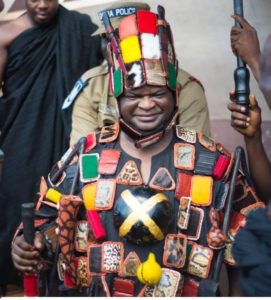
His Majesty Katakyie Kwasi Bumagama II
The Royal House of Sefwi Obeng-Mim is under the Paramount King of Sefwi Wiawso Traditional Kingdom, His Majesty Katakyie Kwasi Bumagama II. The Sefwi kingdom goes back in history to the ancient times of Ghana.
The Sefwi are an Akan sub-group who live predominantly in Western North Region of Ghana. The Akan sub-group speak the Akan dialect Sefwi language. The term Sefwi, which refers to the language spoken by the Sefwi is said to have mythically originated as a result of the Twi phrase, “Asa awie” ( which translates to “War is over”), by immigrants from Bono-Techiman, Wenchi, Adanse, Denkyira, Assin and Asante who settled in modern-day Sefwi after escaping wars in the 17th century.
The Sefwi like other Akan tribes originated from the ancient world; Northern part of modern Africa. As a result of wars, many families migrated to their present domains. For example, Obumangama of Sefwi Wiawso fame was told to have established his domain at Ewiaso because of its strategic position.
Sefwi, collectively is made up of three traditional states namely Anhwiaso, Bekwai, and Wiawso, all of which have a mutually independent paramount chief and share a common deity Sobore and a common yam festival called Alluolue or Elue.
The Sefwi Wiawso Traditional Kingdom covers an area of 2,695 square miles crossed by the Tano and Bia Rivers, and is approximately the size of the states of Delaware and Rhode Island combined. The Sefwi Wiawso Traditional Kingdom has five major towns including the capital of Sefwi Wiawso, and the total population according to last census was 572,020.
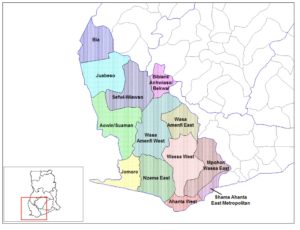
map showing the location of the Sefwi-Wiawso municipal area
The kingdom of Sefwi Obeng-Mim
As stated earlier, the Royal House of Sefwi Obeng-Mim is under the Paramount King of Sefwi Wiawso Traditional Kingdom, His Majesty Katakyie Kwasi Bumagama II. The Sefwi kingdom goes back in history to the ancient times of Ghana.
Sefwi Obeng-Mim is composed of numerous farming communities in Juabeso District in the Western Region of the Republic of Ghana. The ObengMim Stool lands have about 1,500 people, many who are subsistent cocoa farmers. The primary development area is located in the middle of the Krokosue Forest Reserve under Sefwi Wiawso Traditional area, one of the biggest forest reserves in Ghana.
In addition to the agricultural and natural resources produced within the kingdom, there are numerous venues showcasing Ghana’s natural beauty and culture. The famous Alluolue Yam Festival is held each November. The festival was historically celebrated to mark the beginning of harvest and the way that traditional leaders would manage and distribute produce among the people in order to prevent hunger, (traditionally no one is permitted to eat yam before the festival begins.) A natural forest reserve where many animal species offers opportunities for camera safaris and the area is home to several sacred sites such as the Tree of God (Nyame Dua), the Ancestral Hole (which has healing powers), and the Abombirim Sacred Tortoise Forest.
Making a King in the Royal House of Sefwi Obeng-Mim
Chiefs are selected from the royal family. Those who select the chief are the kingmakers.
In the southern part of Ghana, especially among the Akan, the queen mother nominates the candidate. This nomination must be approved by the kingmakers. The kingmakers therefore determine who is to be the chief. After the approval by the kingmakers, the elected candidate is introduced to the community. He is carried shoulder high through the main streets of the town.
The chief-elect is kept in a room for some time before he is “outdoored”. During this period of confinement, he is taught the history, tradition, customs, and practices of his people. He is also cleansed spiritually for his new role.
On the day of enstoolment, the chief-elect is beautifully dressed and carried in a palanquin through the main streets of the town. After this he swears the oath of allegiance to his people. His sub-chiefs in turn swear to him, on behalf of the people. After this, he is taken to the stool room where he is made to ‘sit’ on the stool three times. He then chooses a stool name for himself.
The Historic Succession of Sefwi Obeng-Mim Kings
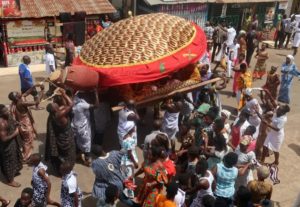
Royal umbrella traditionally used to shade the king and his sub-chiefs
- Nana Kwame Obeng I (1935-1960)
- Nana yaw Brobbery (1960-1990)
- Nana Kofi Ntori (1990-2001)
- Nana Kwame Ofori (2001-2005)
- Nana Kwame Wusu I (2005-2011)
- Nana Kwame Ofori II (2011-2016)
- Oheneba Nana Kwame Obeng II (2016-Current)
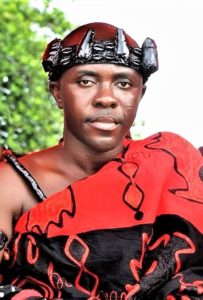
His Majesty Oheneba Nana Kwame Obeng II
His Majesty Oheneba Nana Kwame Obeng II, known in his private life as Mr. Ofosuhene Dacosta, was enstooled and outdoored as the Chief/King of Sefwi Obeng-Mim within the Sefwi Wiawso Traditional Royal House of Sefwi Obeng-Mim on 3rd June 2016. Nana is recognized by the Sefwi Wiawso Traditional Council as the rightful enstooled chief of the area by the Elders and Kingmakers. The Paramount Chief of the Sefwi Wiawaso Tradition Area and President of the Sefwi Wiawso Traditional Council is H.M. Katakyie Kwasi Bumagama II, father of H.M. Oheneba Nana Kwame Obeng II. H.M. Katakyie Kwasi Bumagama II elevated H.M. Oheneba Nana Kwame Obeng II as a Divisional Chief on 16th July 2017.
Charitable interests
His Majesty Oheneba Nana Kwame Obeng II is committed to serving the people of the kingdom, the traditional area, and Africa as a whole. With mobility issues and basic developmental projects being of paramount concern, his majesty has initiated projects designed to provide safe and clean potable water, medical and educational infrastructure, as well as educational programs to the people of the kingdom. He has successfully completed several projects in the area, including three-unit School Building; completion of a Village Water Well; procurement of school supplies, including several children’s backpacks, school furniture, teaching equipment, uniforms, and assistance with teacher salaries. For more information on specific charitable activities undertaken by His Majesty Oheneba Nana Kwame Obeng II, please view the Royal House of Sefwi Obeng-Mim’s 2020 mid-year development report which can be found at https://www.royalhousemim.org/pdf/DevelopmentReport_2020MidYear.pdf. Information on ways to support these worthwhile activities can be found at https://www.royalhousemim.org/projects.

a water well built as a result of His Majesty Oheneba Nana Kwame Obeng II's efforts
THE ROYAL ORDERS OF SEFWI OBENG-MIM
The Kingdom of Sefwi Obeng-Mim instituted a system of dynastic orders related to area history and legend as a way to recognize persons providing service to the royal house. The Royal Orders of Sefwi Obeng-Mim use a system of honors modeled after traditional European orders.
The Royal Orders of Sefwi Obeng-Mim are typically granted for life in all grades. However, on a rare occasion, orders at the Grand Collar level, may be granted as a hereditary dignity to reward exceptional service to the Royal House.
All members are entitled to wear the appropriate Insignia for their grade in the Order. Members are allowed to use the Order’s Insignia in their heraldry reflecting the appropriate grade.
The Royal Order of the Golden Fire Dog
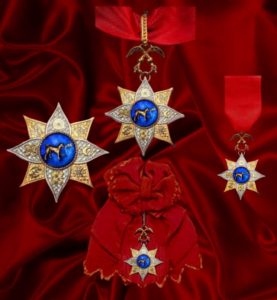
Sash, breast star, neck medal, and chest ribbon of the order
The Aduana people are believed to have been led out of the ground by a dog which had fire in his mouth. Hence they are referred to as Ogyaasefuo. It is also believed that the first Aduana had a dog that once was out to search for food and on seeing fire, the dog thought there was something to eat for him, and in doing so got his mouth seriously burnt. When the owner saw it coming with the fire he then said, “m’atwea woabre me adie” meaning ‘my dog you have brought me something worthy’.
The Royal Order of the Golden Fire Dog was constituted and inaugurated under the auspices of the Royal House of Sefwi Obeng-Mim, in order to promote the ancient code of the military protectors “Adontehene” (one who goes in front of the army) of an ancient Akan Kingdom, dating back to time immemorial; who are now in service to the Royal House of Sefwi ObengMim.
The International members of this Royal Order are dedicated to the development of the Stool Lands under the care of the Royal House. Acceptance into the Order is based on the assessment of the human values and quality of character of the applicant, without distinction or discrimination based on religious, social class, race, political tendencies, physical disability, or sexual orientation. Advancement in rank is based on merit.
The ranks, in order of accession:
Member, Royal Order of the Golden Fire Dog (MG);
Knight/Dame, Royal Order of the Golden Fire Dog (KG/DG). The decoration hangs from the ribbon that is worn at chest height on the left-hand side of the clothing. The ribbon for women is tied in the shape of a bow. The miniature is tied in the shape of a bow.
Knight/Dame Commander, Order of the Golden Fire Dog (KCG/DCG). The decoration hangs from a ribbon. This ribbon is smaller in diameter than the ribbon of a Grand Cross. The star consists of a slightly larger decoration, which is worn directly above the middle on the left-hand side of the clothing. The star and the decoration described above are always worn together.
Knight/Dame Grand Officer. Knight, Grand Officer, Order of the Golden Fire Dog (KGOG/DGOG). The decoration hangs from a neck ribbon. The star, consisting of the decoration symbols important to African culture, is attached to an eight-pointed slightly rounded golden star consisting of braided silver and golden rays. The rays of the star are alternately braided and all tied at the ends. The star is worn directly above the waist on the left-hand side of the clothing. The star and the medal described above are always worn together.
Knight/Dame Grand Gross. Knight, Grand Cross, Order of the Golden Fire Dog (KGCG/DGCG). The decoration hangs from a ribbon. This is tied as a sash, which is worn from the right shoulder to the left hip. The star, consisting of the decoration symbols important to African culture, is attached to an eight-pointed slightly rounded golden star consisting of braided silver and golden rays. The rays of the star are alternately braided and all tied at the ends. The star is worn directly above the waist on the left-hand side of the clothing. The star and the medal described above are always worn together.
The Royal Order of Obeng II
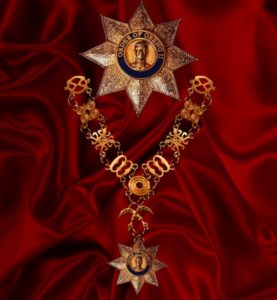
Breast star of the Knight/Dame Grand Cross of the Order of Obeng II and the Grand Collar of the order
The Royal Order of Obeng II is designed as a dynastic order of merit reflecting the traditional African royal orders that differentiates them clearly from European models. The membership of this order is restricted to the Chief or King of Obeng-Mim Stool Land and the very few other persons who have honored the king and the kingdom through their noble acts of love and charity that build up the kingdom and its legacy for future generations. The king is the Grand Master of the Royal Order and grants the dignity of the Order to others found to be of merit by His Majesty and the Royal House. Those who hold the rank of Knight Grand Cross of the Royal Order of the Golden Fire Dog may receive the order of merit of Knight/Dame Grand Cross of the Order of Obeng II (KGCO/DGCO). The king may also grant the order of merit of Obeng II, rank of Grand Collar (GCO) to other recognized heads and members of royal houses, nobles, and heads of state, as well as a lifetime achievement to a member of the Royal Order of the Golden Fire Dog.
This section was produced with the generous permission of His Majesty Oheneba Nana Kwame Obeng II and the invaluable assistance of His Excellency, Dr. Christian Boyd, Grand Chancellor of the Royal Orders, who provided a majority of the reference material used on this page. His Majesty Oheneba Nana Kwame Obeng II works tirelessly to promote development throughout the region and to protect the culture and traditions of his people. For more information on the Kingdom of Sefwi Obeng-Mim, the Dynastic Orders of the Royal Household, or to inquire about ways to donate and support His Royal Highness’ humanitarian activities, please visit the website of the Royal House of Sefwi Obeng-Mim at https://www.royalhousemim.org/home
